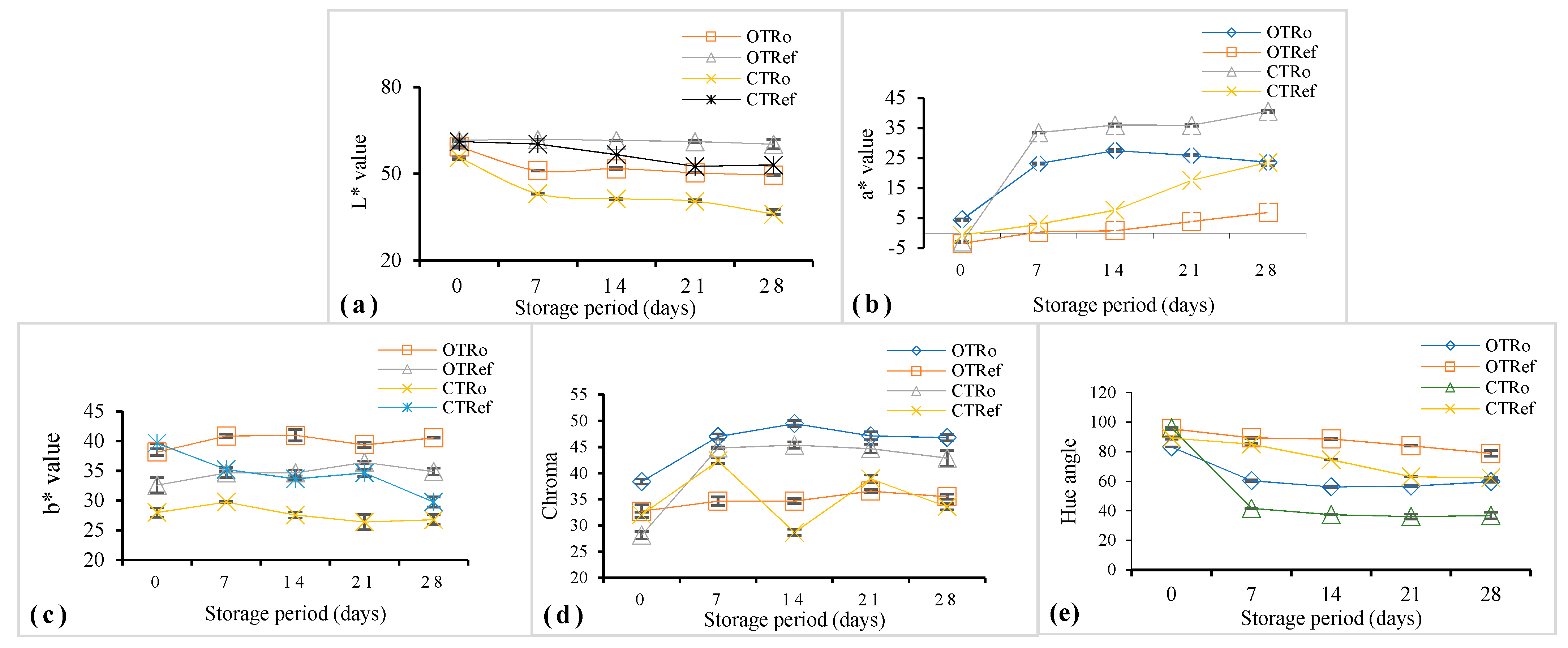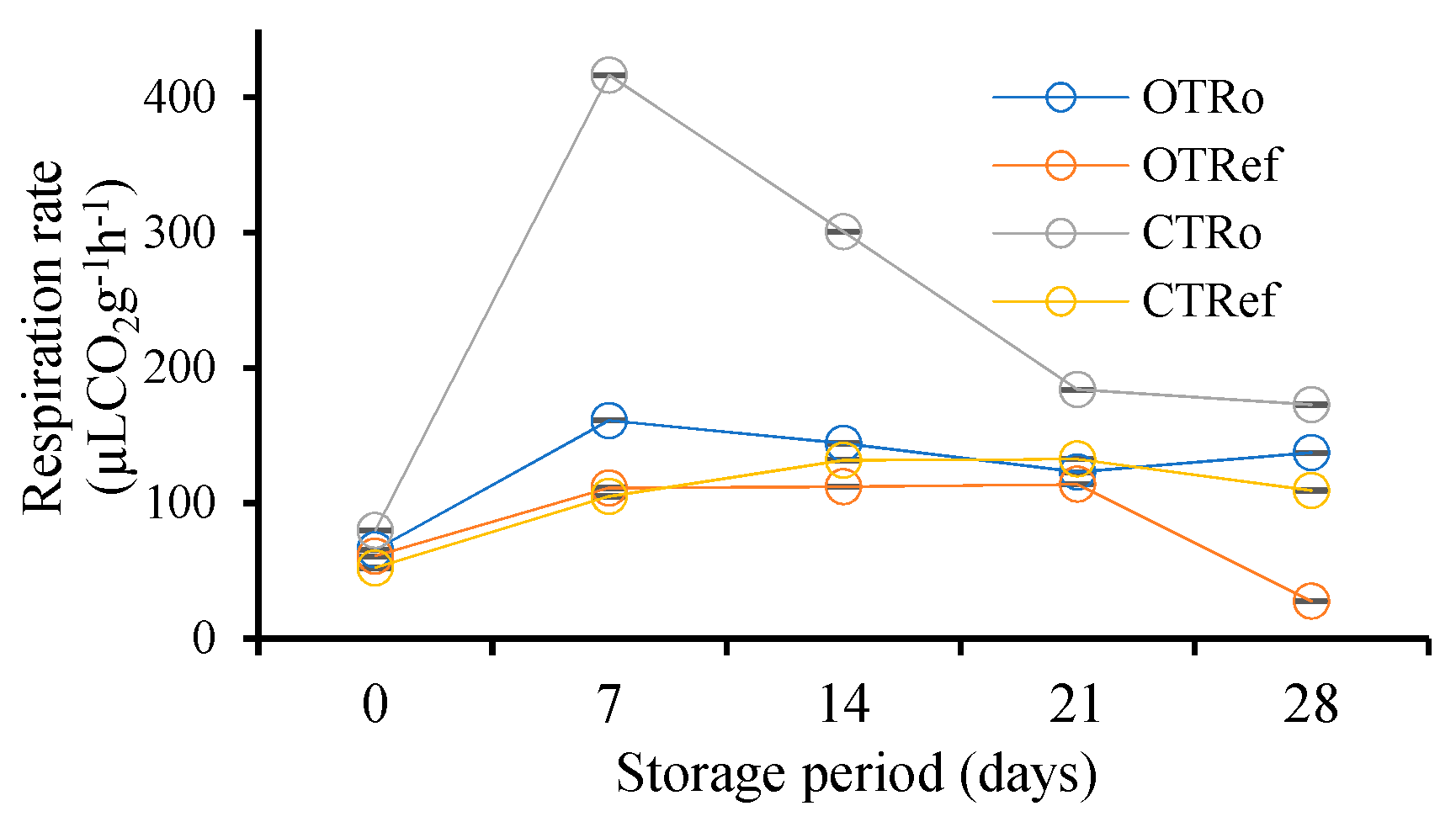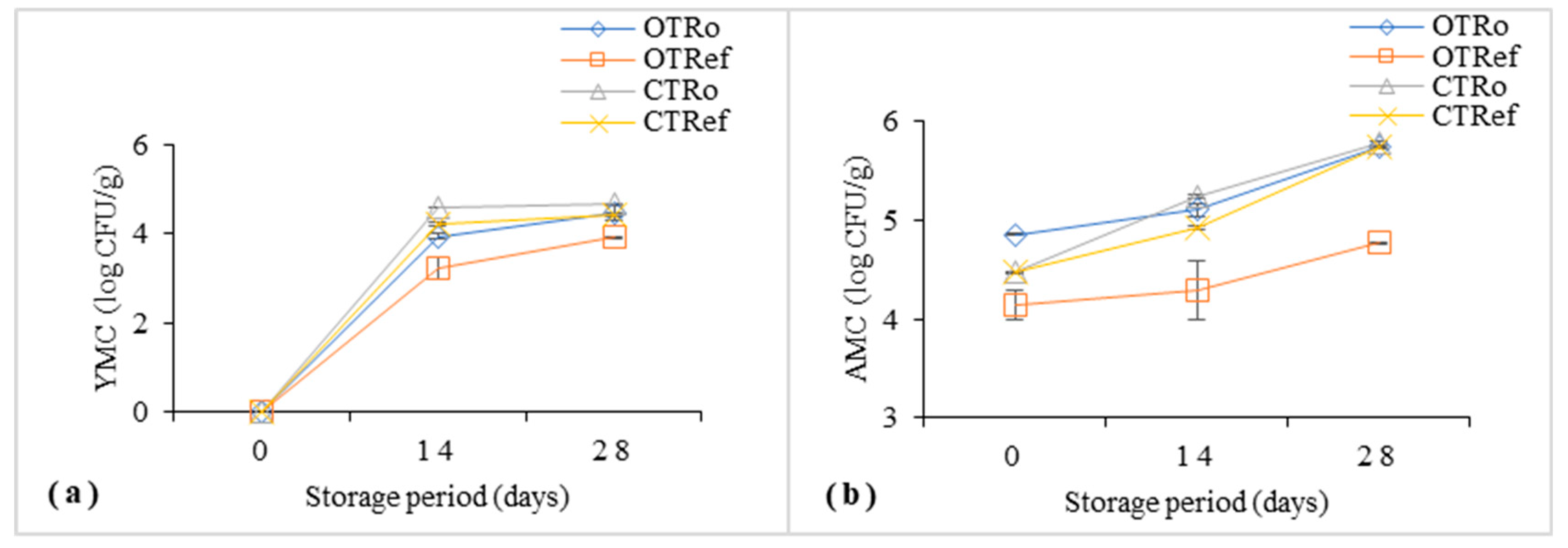Postharvest Quality and Storability of Organically versus Conventionally Grown Tomatoes: A Comparative Approach †
Abstract
:1. Introduction
2. Materials and Methods
2.1. Experimental Design
2.2. Physical Parameters
2.3. Chemical Parameters
2.4. Microbial Analysis
2.5. Statistical Analysis
3. Result and Discussion
3.1. Physical Parameters
3.2. Postharvest Chemical Parameters
3.3. Microbial Stability
4. Conclusions
Author Contributions
Funding
Institutional Review Board Statement
Informed Consent Statement
Data Availability Statement
Acknowledgments
Conflicts of Interest
References
- Mitra, S.; Devi, H. Organic Horticulture in India. Horticulturae 2016, 2, 17. [Google Scholar] [CrossRef]
- Mditshwa, A.; Magwaza, L.S.; Tesfay, S.Z.; Mbili, N. Postharvest Quality and Composition of Organically and Conventionally Produced Fruits: A Review. Sci. Hortic. 2017, 216, 148–159. [Google Scholar] [CrossRef]
- Rahman, S.M.E.; Mele, M.A.; Lee, Y.-T.; Islam, M.Z. Consumer Preference, Quality, and Safety of Organic and Conventional Fresh Fruits, Vegetables, and Cereals. Foods 2021, 10, 105. [Google Scholar] [CrossRef] [PubMed]
- Tutika, S.; Dara, S.; Saikia, N.; Cherukuri, S.R. Screening and Isolation of Beneficial Microorganisms from Natural and Organic Concoctions Collected from Various Parts of Andhra Pradesh and Telangana. Biopestic. Int. 2018, 14, 101–108. [Google Scholar]
- Gopinath, K.A.; Mitnala, J. Organic Farming Research in India: Present Status and Way Forward. Int. J. Econ. Plants 2018, 3, 98–101. [Google Scholar] [CrossRef]
- Panwar, A.S.; Dutta, D.; Kumar, A.; Meena, L.K.; Meena, A.L. Modern Concepts and Practices of Organic Farming for Safe Secured and Sustainable Food Production; Indian Institute of Farming Systems Research: Meerut, India, 2019; pp. 1–72. [Google Scholar]
- Hiremath, R.; Ke, U. Analysis of Diversified Rice Based Cropping Systems under Organic Management. J. Pharmacogn. Phytochem. 2019, 8, 1118–1120. [Google Scholar]
- Smith, J.; Yeluripati, J.; Smith, P.; Nayak, D.R. Potential Yield Challenges to Scale-up of Zero Budget Natural Farming. Nat. Sustain. 2020, 3, 247–252. [Google Scholar] [CrossRef]
- Boraiah, B.; Devakumar, N.; Shubha, S.; Palanna, K.B. Effect of Panchagavya, Jeevamrutha and Cow Urine on Beneficial Microorganisms and Yield of Capsicum (Capsicum annuum L. Var. Grossum). Int. J. Curr. Microbiol. Appl. Sci. 2017, 6, 3226–3234. [Google Scholar] [CrossRef]
- Gore, N.S.; Sreenivasa, M.N. Influence of Liquid Organic Manures on Growth, Nutrient Content and Yield of Tomato (Lycopersicon Esculentum Mill.) in the Sterilized Soil. Karnataka J. Agric. Sci. 2011, 24, 153–156. [Google Scholar]
- Koraddi, V.V.; Devendrappa, S. Analysis of Physiological Loss of Weight of Vegetables under Refrigerated Conditions. J. Farm Sci. 2011, 1, 61–68. [Google Scholar]
- Massantini, R.; Radicetti, E.; Frangipane, M.T.; Campiglia, E. Quality of Tomato (Solanum Lycopersicum L.) Changes under Different cover Crops, Soil Tillage and Nitrogen Fertilization Management. Agricultural 2021, 11, 106. [Google Scholar] [CrossRef]
- Pandurangaiah, S.; Sadashiva, A.T.; Shivashankar, K.S.; Sudhakar Rao, D.V.; Ravishankar, K.V. Carotenoid Content in Cherry Tomatoes Correlated to the Color Space Values L∗, A∗, B∗: A Non-Destructive Method of Estimation. J. Hortic. Sci. 2020, 15, 27–34. [Google Scholar] [CrossRef]
- Ghoora, M.D.; Srividya, N. Effect of Packaging and Coating Technique on Postharvest Quality and Shelf Life of Raphanus Sativus L. and Hibiscus Sabdariffa L. Microgreens. Foods 2020, 9, 653. [Google Scholar] [CrossRef] [PubMed]
- Shehata, S.A.; Abdelrahman, S.Z.; Megahed, M.M.A.; Abdeldaym, E.A.; El-Mogy, M.M.; Abdelgawad, K.F. Extending Shelf Life and Maintaining Quality of Tomato Fruit by Calcium Chloride, Hydrogen Peroxide, Chitosan, and Ozonated Water. Horticulturae 2021, 7, 309. [Google Scholar] [CrossRef]
- Teka, T.A. Analysis of the Effect of Maturity Stage on the Postharvest Biochemical Quality Characteristics of Tomato (Lycopersicon Esculentum Mill.) Fruit. Int. Res. J. Pharm. Appl. Sci. 2013, 3, 180–186. [Google Scholar]
- Mehta, N.; Patani, P.; Singhvi, I. Colorimetric Estimation of Ascorbic Acid from Different Varities of Tomatoes Cultivated in Gujarat. World J. Pharm. Res. 2018, 7, 1376–1384. [Google Scholar]
- Hussein, J.B.; Sanusi, M.S.; Filli, K.B. Evaluation of Drying Methods on the Content of Some Bio-Actives (Lycopene, -Carotene and Ascorbic Acid) of Tomato Slices. Afr. J. Food Sci. 2016, 10, 359–367. [Google Scholar] [CrossRef]
- Merlini, V.V.; Pena, F.D.L.; Da Cunha, D.T.; De Oliveira, J.M.; Rostagno, M.A.; Antunes, A.E.C. Microbiological Quality of Organic and Conventional Leafy Vegetables. J. Food Qual. 2018, 2018, 4908316. [Google Scholar] [CrossRef]
- Eboibi, O.; Isaac, O.; Nyorere, O.; Oghenerukevwe, P.; Uguru, H. Annals of Agricultural Sciences Effect of Pre-Harvest Applications of Organic Manure and Calcium Chloride on the Storability of Tomato Fruits. Ann. Agric. Sci. 2021, 66, 142–151. [Google Scholar] [CrossRef]
- Memon, N.; Gat, Y.; Arya, S.; Waghmare, R. Combined Effect of Chemical Preservative and Different Doses of Irradiation on Green Onions to Enhance Shelf Life. J. Saudi Soc. Agric. Sci. 2020, 19, 207–215. [Google Scholar] [CrossRef]
- Morra, L.; Cozzolino, E.; Salluzzo, A.; Modestia, F.; Bilotto, M.; Baiano, S.; Del Piano, L. Plant Growth, Yields and Fruit Quality of Processing Tomato (Solanum Lycopersicon L.) as Affected by the Combination of Biodegradable Mulching and Digestate. Agronomy 2021, 11, 100. [Google Scholar] [CrossRef]
- Bilalis, D.; Roussis, I.; Papastylianou, P.; Cheimona, N. Effects of Organic and Inorganic Fertilization on Yield and Quality of Processing Tomato (Lycopersicon Esculentum Mill.). Folia Hortic. 2018, 30, 321–332. [Google Scholar] [CrossRef]
- Ünlü, H.; Ünlü, H.Ö.; Karakurt, Y.; Padem, H. Influence of Organic and Conventional Production Systems on the Quality of Tomatoes during Storage. Afr. J. Agric. Res. 2011, 6, 538–544. [Google Scholar]
- Ayomide, O.B.; Ajayi, O.O.; Ajayi, A.A. Advances in the Development of a Tomato Postharvest Storage System: Towards Eradicating Postharvest Losses. J. Phys. Conf. Ser. 2019, 1378, 022064. [Google Scholar] [CrossRef]
- Navarro, M.; Bosch, S.M. Reduced Phosphate Availability Improves Tomato Quality Through Hormonal Modulation in Developing Fruits. J. Plant Growth Regul. 2022, 41, 153–162. [Google Scholar] [CrossRef]
- Kim, Y.X.; Son, S.; Lee, S.; Jung, E.; Lee, Y.; Sung, J.; Lee, C. Combined Effects of Nutrients × Water × Light on Metabolite Composition in Tomato Fruits (Solanum Lycopersicum L.). Plants 2021, 10, 1437. [Google Scholar] [CrossRef]
- Iqbal, H.M.; Akbar, Q.; Arif, S.; Khurshid, S. Maturity Dependent Changes in Post-Harvest Physiological, Antioxidant and Anti-Microbial Attributes of Tomato. Pak. J. Agric. Sci. 2022, 35, 144–153. [Google Scholar] [CrossRef]
- Tilahun, S.; Park, D.S.; Solomon, T.; Choi, H.R.; Jeong, C.S. Maturity Stages Affect Nutritional Quality and Storability of Tomato Cultivars. CYTA-J. Food 2019, 17, 87–95. [Google Scholar] [CrossRef]
- Toor, R.K.; Savage, G.P.; Heeb, A. Influence of Different Types of Fertilisers on the Major Antioxidant Components of Tomatoes. J. Food Compos. Anal. 2006, 19, 20–27. [Google Scholar] [CrossRef]
- Okolie, N.P. Effect of Post Harvest Treatments on Quality of Whole Tomatoes. Afr. J. Food Sci. 2012, 6, 70–76. [Google Scholar] [CrossRef]
- Fagundes, C.; Moraes, K.; Pérez-Gago, M.B.; Palou, L.; Maraschin, M.; Monteiro, A.R. Effect of Active Modified Atmosphere and Cold Storage on the Postharvest Quality of Cherry Tomatoes. Postharvest Biol. Technol. 2015, 109, 73–81. [Google Scholar] [CrossRef]
- Javanmardi, J.; Kubota, C. Variation of Lycopene, Antioxidant Activity, Total Soluble Solids and Weight Loss of Tomato during Postharvest Storage. Postharvest Biol. Technol. 2006, 41, 151–155. [Google Scholar] [CrossRef]
- Alkan, N.; Fortes, A.M. Insights into Molecular and Metabolic Events Associated with Fruit Response to Post-Harvest Fungal Pathogens. Front. Plant. Sci. 2015, 6, 889. [Google Scholar] [CrossRef] [PubMed]




| Parameters | Sample | Storage Period (Days) | ||||
|---|---|---|---|---|---|---|
| 0 Days | 7 Days | 14 Days | 21st Days | 28th Days | ||
| TSS (°Brix) | OTRo | 3.67 ± 0.23 a | 3.20 ± 0.00 a | 3.90 ± 0.00 a | 4.00 ± 0.00 b | 3.50 ± 0.00 a |
| CTRo | 4.53 ± 0.06 b | 4.20 ± 0.00 c | 4.50 ± 0.00 c | 3.70 ± 0.10 a | 4.10 ± 0.10 bc | |
| OTRef | 3.70 ± 0.00 a | 4.10 ± 0.10 b | 4.13 ± 0.06 b | 3.90 ± 0.00 ab | 4.13 ± 0.06 c | |
| CTRef | 4.50 ± 0.00 b | 4.70 ± 0.00 d | 4.87 ± 0.06 d | 5.20 ± 0.26 c | 4.00 ± 0.00 b | |
| Titratable acidity (% citric acid equivalent) | OTRo | 0.38 ± 0.03 a | 0.26 ± 0.03 a | 0.32 ± 0.00 a | 0.39 ± 0.01 b | 0.24 ± 0.02 ab |
| CTRo | 0.46 ± 0.02 b | 0.64 ± 0.00 c | 0.51 ± 0.03 c | 0.48 ± 0.03 c | 0.30 ± 0.02 c | |
| OTRef | 0.37 ± 0.02 a | 0.30 ± 0.02 b | 0.43 ± 0.02 b | 0.35 ± 0.01 a | 0.27 ± 0.05 bc | |
| CTRef | 0.53 ± 0.02 c | 0.96 ± 0.00 d | 1.14 ± 0.02 d | 0.70 ± 0.00 d | 0.20 ± 0.02 a | |
| pH | OTRo | 4.44 ± 0.01 b | 4.41 ± 0.01 c | 4.52 ± 0.01 d | 4.56 ± 0.01 c | 4.54 ± 0.00 b |
| CTRo | 4.45 ± 0.01 b | 4.49 ± 0.01 d | 4.16 ± 0.06 a | 4.37 ± 0.01 a | 4.72 ± 0.01 c | |
| OTRef | 4.38 ± 0.01 a | 4.38 ± 0.00 b | 4.30 ± 0.00 b | 4.40 ± 0.01 b | 4.49 ± 0.01 a | |
| CTRef | 4.72 ± 0.01 c | 4.19 ± 0.00 a | 4.37 ± 0.02 c | 4.75 ± 0.01 d | 4.78 ± 0.02 d | |
| Ascorbic acid (mg/100 g) | OTRo | 23.53 ± 0.21 d | 5.07 ± 0.10 d | 13.29 ± 1.28 ab | 13.15 ± 1.55 b | 9.24 ± 0.30 b |
| CTRo | 13.86 ± 0.01 c | 10.18 ± 0.20 b | 15.20 ± 1.13 b | 10.49 ± 0.70 a | 8.10 ± 0.11 a | |
| OTRef | 23.56 ± 0.20 a | 16.18 ± 0.20 c | 16.21 ± 1.19 b | 17.79± 1.03 c | 9.85 ± 0.02 c | |
| CTRef | 13.78 ± 0.01 b | 7.01 ± 0.03 a | 11.78 ± 1.65 a | 15.86 ± 0.70 c | 8.15 ± 0.13 a | |
| Lycopene (mg/kg of fresh tomatoes) | OTRo | 8.43 ± 0.01 d | 9.17 ± 0.17 b | 20.73 ± 0.02 d | 27.65 ± 0.31 c | 44.84 ± 1.91 c |
| CTRo | 7.30 ± 0.01 a | 40.13 ± 0.45 d | 52.59 ± 0.09 c | 93.76 ± 0.22 d | 117.38 ± 1.56 d | |
| OTRef | 8.01 ± 0.01 c | 6.83 ± 0.03 a | 15.94 ± 0.00 b | 21.62 ± 0.54 a | 26.82 ± 0.54 a | |
| CTRef | 7.62 ± 0.02 b | 11.93 ± 1.50 c | 3.73 ± 0.02 a | 22.86 ± 0.07 b | 29.69 ± 0.52 b | |
Publisher’s Note: MDPI stays neutral with regard to jurisdictional claims in published maps and institutional affiliations. |
© 2022 by the authors. Licensee MDPI, Basel, Switzerland. This article is an open access article distributed under the terms and conditions of the Creative Commons Attribution (CC BY) license (https://creativecommons.org/licenses/by/4.0/).
Share and Cite
Pradhan, A.; Srijaya, M. Postharvest Quality and Storability of Organically versus Conventionally Grown Tomatoes: A Comparative Approach. Biol. Life Sci. Forum 2022, 16, 29. https://doi.org/10.3390/IECHo2022-12513
Pradhan A, Srijaya M. Postharvest Quality and Storability of Organically versus Conventionally Grown Tomatoes: A Comparative Approach. Biology and Life Sciences Forum. 2022; 16(1):29. https://doi.org/10.3390/IECHo2022-12513
Chicago/Turabian StylePradhan, Alisha, and Mupparapu Srijaya. 2022. "Postharvest Quality and Storability of Organically versus Conventionally Grown Tomatoes: A Comparative Approach" Biology and Life Sciences Forum 16, no. 1: 29. https://doi.org/10.3390/IECHo2022-12513






